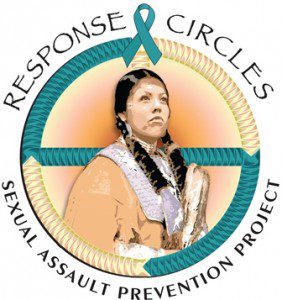
Domestic and sexual violence in Indian Country has been a quiet issue despite the growing epidemic. Federal data indicate that one in every three AI/AN women (34%) will have been raped in their lifetime, which is 2.5 times more than women of other races. Close to 40% of Native women will experience intimate partner violence in their lifetime. Compared to women of other races, Native women who are assaulted are more likely to have severe injuries that require medical care. Despite the high burden of violence against AI/AN women, a low percentage of assaults are reported or prosecuted. A 2010 study found that U.S. attorneys declined to prosecute 67% of sexual abuse, firearms violations, homicide, and other violent crimes occurring in the lives of AI/AN women.
Men and children also experience intimate partner and sexual violence. It is estimated that nearly one in eight Native men is sexually assaulted in his lifetime, with few resources tailored to their needs. Those who experience sexual violence during childhood – which is among the adverse childhood experiences often referred to as “ACEs” – are at heightened risk for negative sexual and reproductive health outcomes (STIs, teen pregnancy), chronic disease, and mental health disorders.
While there are no comparable data for AI/ANs living in the Pacific Northwest, this national perspective reflects our NW experience. Extensive family relationships are culturally paramount in tribal communities, and it is very difficult to overcome powerful stigma and shame when reporting sexual violence at any age. The victim may see the perpetrator in the small community every day.
The Response Circles project addresses DVPI Purpose Area 1 and will:
- Foster coordination and collaboration among DVPI service providers in the Pacific Northwest, by hosting regional Zoom webinars highlighting model programs and services
- Provide technical assistance Northwest tribes, improving their ability to carry out crisis intervention, counseling, advocacy, behavioral health, or case management services, and their prevention and intervention policies and protocols
- Provide training and travel scholarships to AI/AN medical professionals, first responders, and prevention staff who would like to attend regional trainings, meetings or conferences related to DVPI objectives
- Increase community awareness about domestic and sexual violence services, by disseminating the nationally-recognized, IHS-endorsed social marketing campaigns: My Body, My Mind, My Spirit are Sacred and What is Done to One is Felt by All
- Host one Social Marketing Bootcamp Training per year to design a youth-led marketing campaign that will be delivered nationally through weRnative.org
Collectively, this work will help build and maintain close working relationships with DVPI stakeholders in the region, and will inform the NPAIHB about new prevention strategies and intervention resources available to our NW tribes.
The NPAIHB was awarded funding under the Domestic Violence Prevention Initiative (DVPI) from the Indian Health Service in October 2017. This funding is for four years and will assist staff with re-launching the 2010-2015 Response Circles project previously funded by the DVPI dollars during this five year pilot demonstration project. The IHS DVPI funding works to meet two purpose areas:
- Domestic and Sexual Violence Prevention, Advocacy, and Coordinated Community Responses
- Provide Forensic Healthcare Services. The Response Circles project will focus on purpose area 1 for this round of DVPI funding. To learn more about this funding, please visit www.ihs.gov/dvpi/.
Crisis Resources
- If you or someone you know is in crisis, please call 1-800-656-HOPE (4673)
Idaho Resources
Oregon Resources
- Oregon Attorney General’s Sexual Assault Task Force
- Oregon Coalition Against Domestic & Sexual Violence
Washington Resources
- Washington State Coalition Against Domestic Violence
- Washington Coalition of Sexual Assault programs
- Trainings Through UW Medicine
National Resources
- RAINN, National anti-sexual violence organization
- National Center on Domestic & Sexual Violence
- National Sexual Violence Resource Center (NSVRC)
- Men Can Stop Rape
- Engaging Bystanders in Sexual Violence Prevention
- Sexual Assault Forensic Examinations, Support, Training, Access and Resources (SAFESTAR)
- Sexual Assault Response Team (SART) Toolkit – training on your own
- International Assoc. of Forensic Nurses
- IHS Tribal Forensic Healthcare
- Office for Victims of Crime
- Understanding Me too movement, Sexual harassment awareness- guide
- At your own pace Online Sexual Assault Nurse Examiner’s training
- At your own pace Online Sexual Assault Nurse Examiner’s training
- At your own pace – conference on Crimes against women
- Sexual Assault Response Team (SART) Toolkit – training on your own
Domestic Violence 101 presented by Stronghearts Native Helpline
*NEW* Sexual Assault Posters now available for Download
Defined, sexual assault (SA), “is any type of sexual contact or behavior that occurs without the explicit consent of the recipient. Falling under the definition of sexual assault are sexual activities as forced sexual intercourse, forcible sodomy, child molestation, incest, fondling, and attempted rape” (The United States Department of Justice).
About 9 in 10 American Indian victims of rape or sexual assault were estimated to have had assailants who were non-native (1997 US Department of Justice). 90% of Indian women in chemical dependency treatment are victims of rape and childhood sexual abuse (1998 Presentation to Federal Bar Association Conference. Henry. Tribal Responses to Violence Against Women. Indian Law Section). A report from the American Indian Women’s Chemical Health Project found that 3/4 of Native American women have experienced some type of sexual assault in their lives.
Among communities of color, American Indian/Alaska Native women were most likely to report rape victimization while Asian/Pacific Islander women were least likely to report rape victimization (US Department of Justice).
The United States Department of Justice defines domestic violence (DV) as “a pattern of abusive behavior in any relationship that is used by one partner to gain or maintain power and control over another intimate partner. Domestic violence can be physical, sexual, emotional, economic, or psychological actions or threats of actions that influence another person. This includes any behaviors that intimidate, manipulate, humiliate, isolate, frighten, terrorize, coerce, threaten, blame, hurt, injure, or wound someone”. This can be physical, sexual, emotional, economic, and psychological abuses. To read more about this please visit www.justice.gov/ovw/domestic-violence.
Sometimes intimate partner violence (IPV) is the term used instead of domestic violence and IPV is describes “physical violence, sexual violence, stalking and psychological aggression (including coercive acts) by a current or former intimate partner” (Centers for Disease Control and Prevention). The CDC also defines an intimate partner as a “person with whom one has a close personal relationship that can be characterized by the following: Emotional connectedness; Regular contact; Ongoing physical contact and/or sexual behavior; Identity as a couple and/or; Familiarity and knowledge about each other’s lives”.
DOJ’s Office on Violence Against Women has put together some great resources for victims of IPV that apply to teens and adults.
The Safety Planning Guide link is particularly good.
Recognizing February as National Teen Dating Violence Awareness & Prevention Month
Office on Violence Against Women (OVW) joins the nation in recognizing February as National Teen Dating Violence Awareness and Prevention Month (TDVAM).
In his Teen Dating Violence Awareness & Prevention Month Proclamation President Obama called on all Americans “to stand against dating violence when we see it.”
At a time when an estimated 1 in 10 teens will experience dating violence we all must take this opportunity to amplify our efforts and shine a spotlight on this important issue.
Teen dating violence is violence committed by a person who is or has been in a romantic or intimate relationship with the victim.
It can include physical, sexual, emotional, and verbal violence or abuse, financial control and stalking.
Teen dating violence has negative effects on the mental and physical health of youth, as well as on their school performance.
It can also be a predictor of intimate partner violence and sexual violence perpetration or victimization in later life.
1 in 5 women and nearly 1 in 7 men who have experienced domestic violence first experienced this kind of violence when they were between 11 and 17 years old.
And, we know that if we intervene early, we can often prevent perpetration and victimization in the future.
I would like to share some concrete ways that youth and adults can participate in raising awareness about teen dating violence in your community.
By engaging youth, we can prevent the destructive cycle of abuse and promote safe, healthy relationships among young people.
I am excited to announce the release of innovative new tools created by OVW technical assistance providers.
These remarkable resources can be used throughout the month of February—and beyond.
Safety Planning Guide—a project of Break the Cycle and the National Dating Abuse Helpline.
The interactive planning guide allows youth to create a personalized safety plan for work, school, home and while out with a partner.
It also provides tips, local resources, and a pocket-sized personalized safety checklist.
teenDVmonth Toolkit—a brand new toolkit released by Break the Cycle just in time for TDVAM.
The toolkit provides adult allies with resources to engage communities, especially youth, in a discussion about healthy relationships.
What’s Real Tool Kit—The Idaho Coalition Against Domestic and Sexual Violence’s Center for Healthy Teen Relationships’ new toolkit has an array of resources for use year-round as well as during TDVAM. It includes a youth-led positive social marketing campaign; posters, stickers, bookmarks, and other materials to engage both youth and adult influencers;
and reproducible materials you can use to engage youth online.
That’s Not Cool Ambassador Program—the Ambassador Program is a unique opportunity for teens to raise awareness with friends, family, and the community at large. By completing monthly challenges, That’s Not Cool Ambassadors contribute their unique voices to this national initiative while helping to raise awareness about digital dating abuse in their schools and local communities.
All teens and tweens across the country are invited to join this Futures Without Violence initiative.
There are countless programs, organizations and dedicated individuals who are tireless in their efforts to prevent abuse in dating relationships, and I applaud all of your efforts.
OVW’s youth-serving grantees tell us that everyone can make a difference by reaching out to young people in simple ways.
As we interact with teens in our work or personal lives each of us can act on President Obama’s call to stand against teen dating violence by:
Discussing the warning signs of dating abuse (all kinds, not just physical abuse).
Creating a positive connection to the issue—talk about the characteristics of healthy teen relationships, not just abusive ones—and use statistics sparingly.
Talking about how the media portrays healthy and unhealthy relationships.
For example, many popular movies, TV shows, commercials, books, and magazines portray stalking as romantic or harmless when it is actually very dangerous.
Getting involved even if you don’t have a lot of resources—an information table, classroom discussion, or school announcement can get the conversation started.
Anyone can participate in TDVAM! Visit TeenDVmonth.org—an online hub for national activities and promotion of TDVAM.
The website offers resources for youth, adults and communities that want to plan awareness-raising activities in February.
Consider one of the following activities:
Request a TDVAM proclamation from your state or local government, such as this example from Minnesota.
Register your local school for the National School Announcement.
Ask local school teachers to include a discussion about healthy relationships in their February lesson plans.
Write an op-ed in your local newspaper.
Support youth-led events and projects.
The staff at OVW and I are excited to dive into the month of February and make the increased focus on teen dating violence the new norm as we welcome 2013.
A year that we hope will mark progress and positive change in the field of domestic, sexual and teen dating violence prevention.













